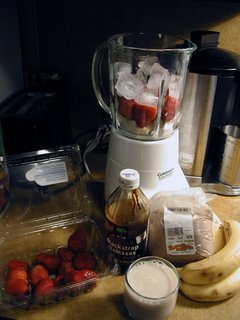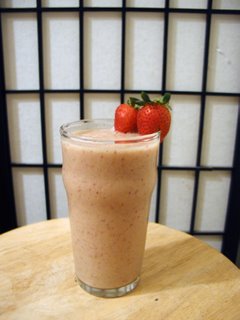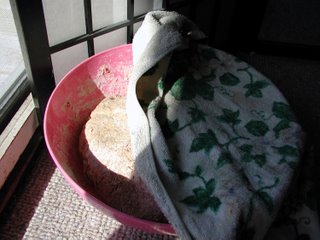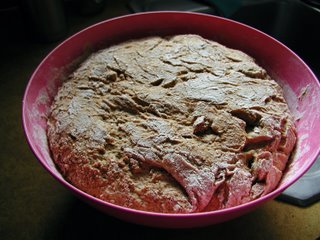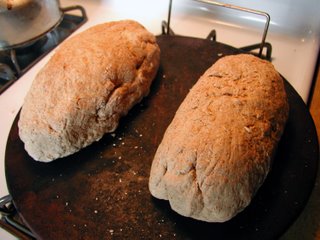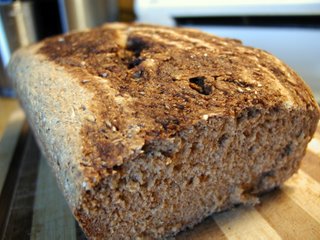Tamale Pie
I borrowed most of this recipe from "Let's Get Baked" a podcast by some guys from Halifax, Canada. Their show is pretty righteous. They come up with good ideas for recipes and the musicians they invite to help are typically very entertaining. There's all sorts of good things to like about it, not the least of which is that I can listen to just about one whole episode during the time it takes me to get from my house to the other side of town on bike. It's a perfect fit, much like this recipe.
This tamale pie basically takes a buch of ingredients you would find in a vegetarian burrito and puts them between layers of baked corn masa, which is found in a tamale. Simple as that.
I started out with a generous mix of:
black beans (cooked in a slow coker)
diced tomatoes
chopped green pepper
sweet corn
a bit of minced garlic
and a teaspoon or two of chile powder
I made a little too much, so as to have some to bring to work the next few days.
Now, you mash everything together for a bit. Doing it in the slow cooker makes the job easy enough. Mash for a minute or so, ut stop before you mash all the beans. You want a few beans to stay in tact, just for texture.

For the crust, you're going to need:
A pot of boiling water (2 1/2 cups)
1 1/2 cups cornmeal
1 teaspoon of salt
1/2 teaspoon of chili powder

Mix up all the ingredients into the boiling water and stir constantly until it thickens. It will get very thick -- thick enough to stand a spoon up. It will also burn if you don't keep stirring.

Take the thickened crust mixture and spread some onto the bottom of a casserole or pie dish. Also, during this time, preheat your oven to 350 degrees.

Now spoon the bean mixture in until it reaches just below the top of the dish. This is your pie filling, so make sure you don't add too much that you can't put a crust on it.

Spread the rest of the cornmeal mixture on to the top of the filling. Spread it all the way out to the sides so it cooks evenly.

Bake it for about 30 minutes, or longer, depending on how crusty you like your pie.

The end result should be something like this.

This stuff has protein, carbs, fiber, and pretty much all the good stuff you need, without too much fat or sodium (depending on how you salt it). I would imagine some extra spices or even salsa might be good on top, if you're feeling up to it.

This tamale pie basically takes a buch of ingredients you would find in a vegetarian burrito and puts them between layers of baked corn masa, which is found in a tamale. Simple as that.
I started out with a generous mix of:
black beans (cooked in a slow coker)
diced tomatoes
chopped green pepper
sweet corn
a bit of minced garlic
and a teaspoon or two of chile powder
I made a little too much, so as to have some to bring to work the next few days.
Now, you mash everything together for a bit. Doing it in the slow cooker makes the job easy enough. Mash for a minute or so, ut stop before you mash all the beans. You want a few beans to stay in tact, just for texture.

For the crust, you're going to need:
A pot of boiling water (2 1/2 cups)
1 1/2 cups cornmeal
1 teaspoon of salt
1/2 teaspoon of chili powder

Mix up all the ingredients into the boiling water and stir constantly until it thickens. It will get very thick -- thick enough to stand a spoon up. It will also burn if you don't keep stirring.

Take the thickened crust mixture and spread some onto the bottom of a casserole or pie dish. Also, during this time, preheat your oven to 350 degrees.

Now spoon the bean mixture in until it reaches just below the top of the dish. This is your pie filling, so make sure you don't add too much that you can't put a crust on it.

Spread the rest of the cornmeal mixture on to the top of the filling. Spread it all the way out to the sides so it cooks evenly.

Bake it for about 30 minutes, or longer, depending on how crusty you like your pie.

The end result should be something like this.

This stuff has protein, carbs, fiber, and pretty much all the good stuff you need, without too much fat or sodium (depending on how you salt it). I would imagine some extra spices or even salsa might be good on top, if you're feeling up to it.

